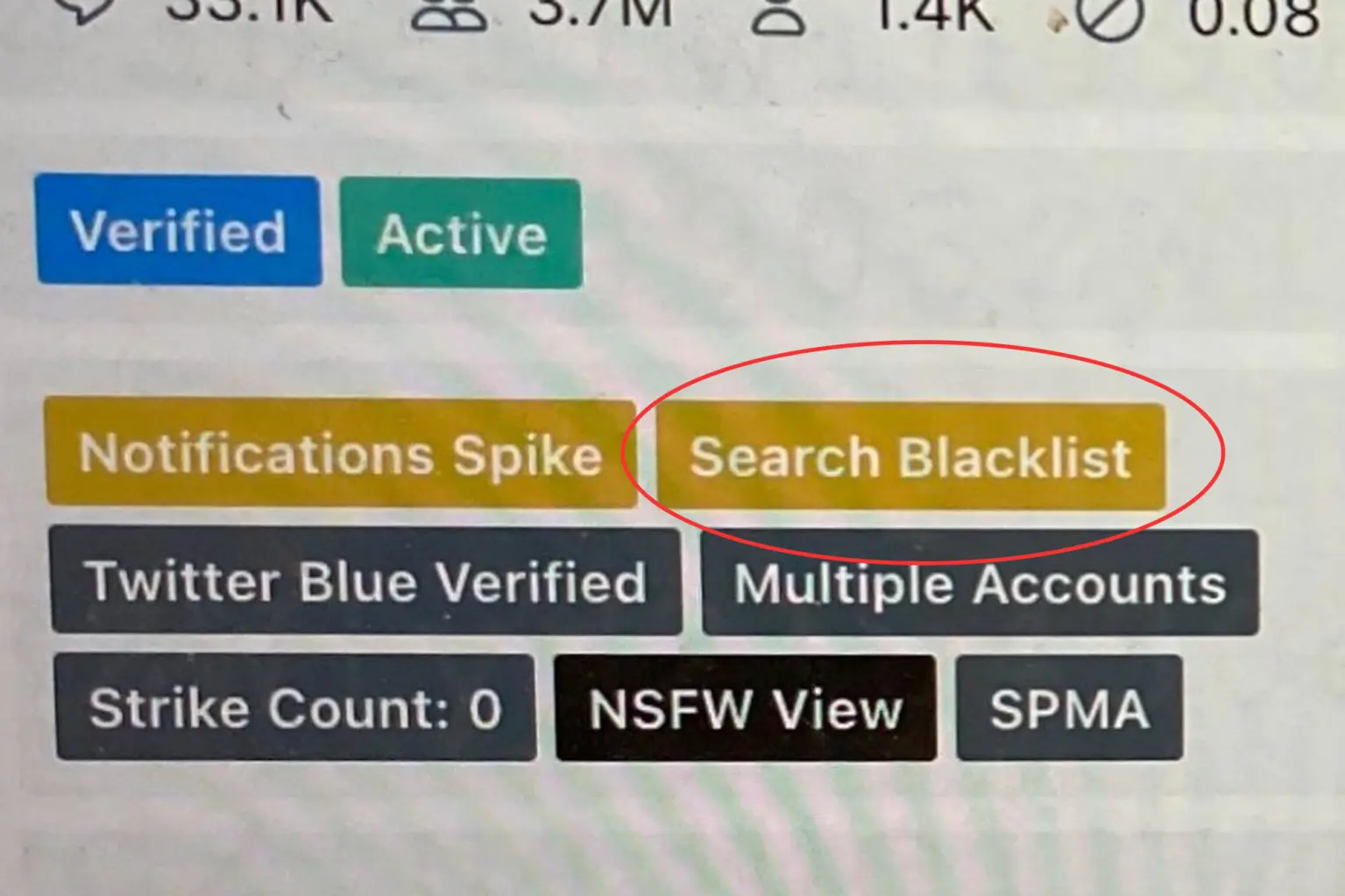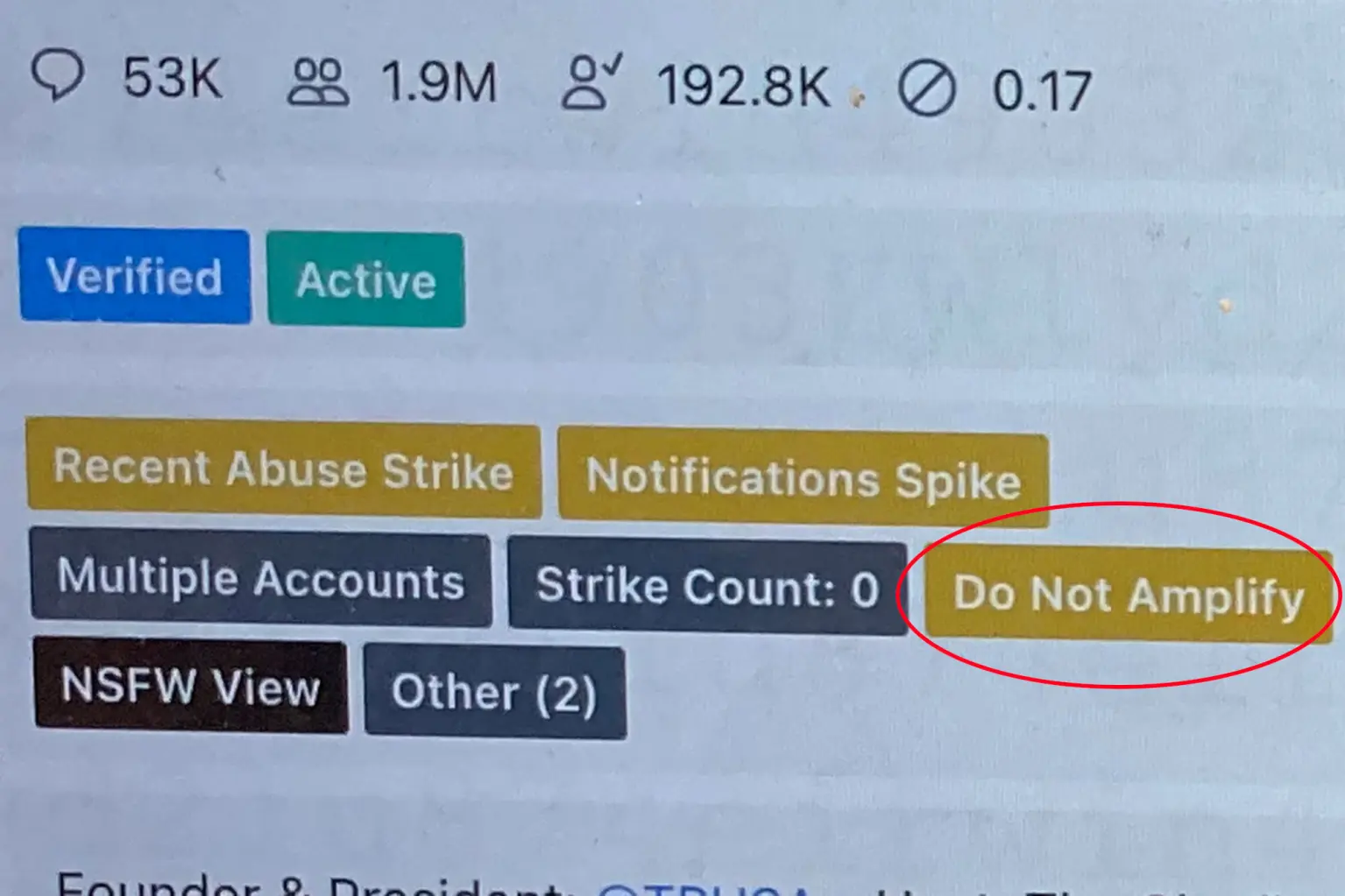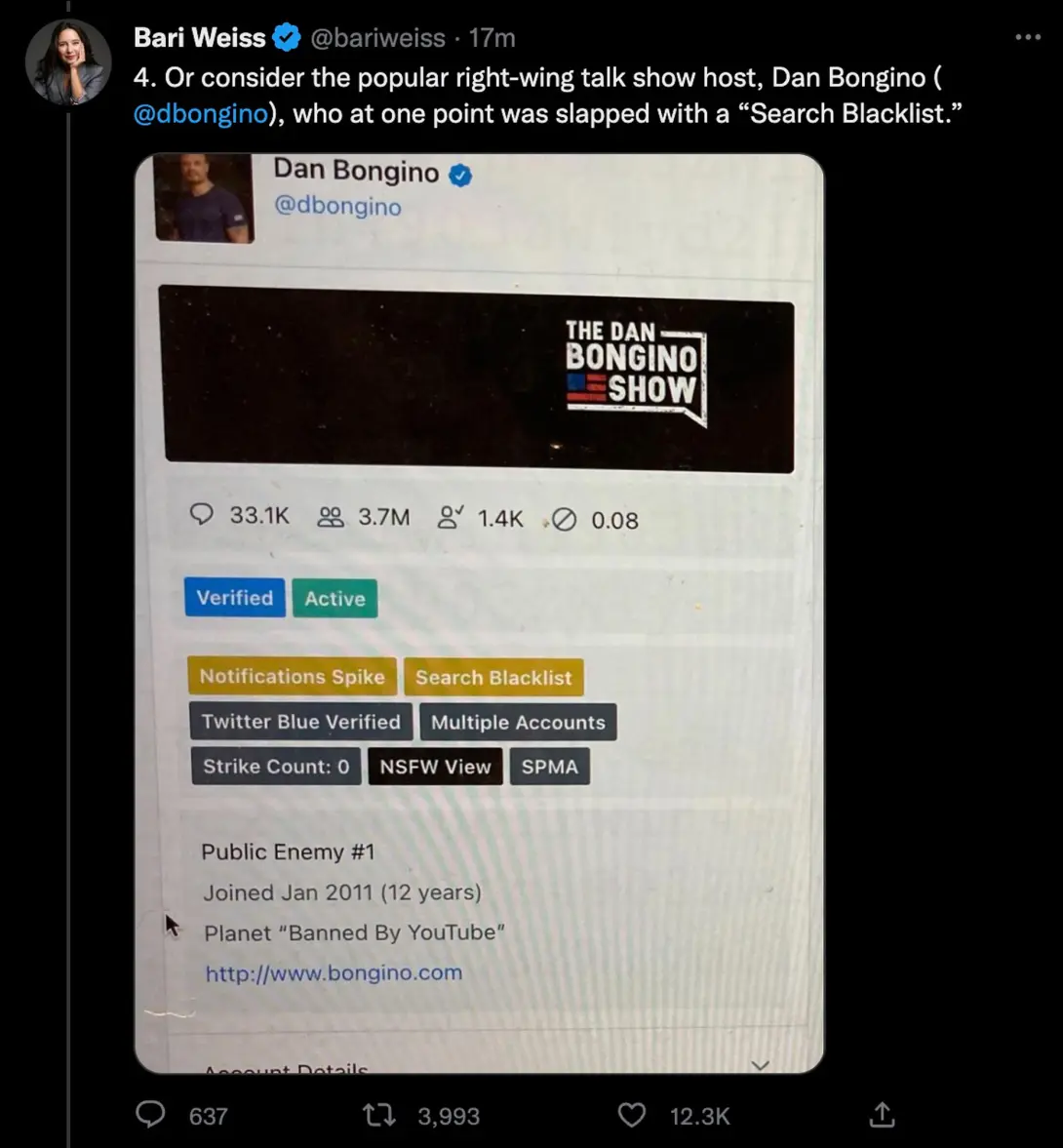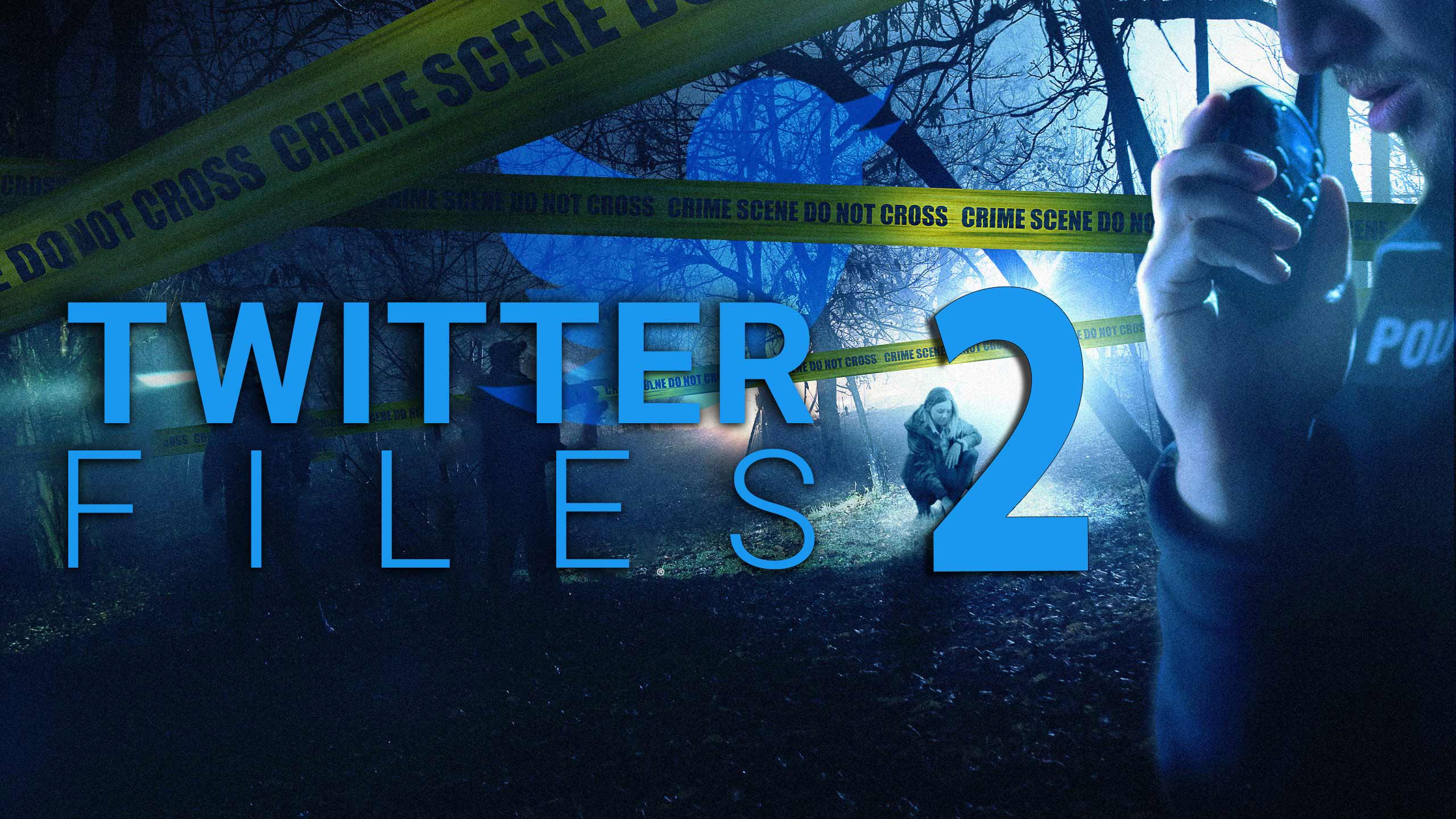The Twitter Files Part 2: Soviet-Style ‘Secret Blacklists’ and Shadow-Bans of Conservatives Exposed
What is in The Twitter Files, Part Two?

The document dump follows a similar batch of recent disclosures from fellow Substacker Matt Taibbi, who dove into the details of Twitter’s October 2020 decision to halt the spread of a New York Post story about a laptop belonging to Hunter Biden. Both Weiss and Taibbi’s threads are part of what Musk is calling “The Twitter Files.”
The thesis of the publication of the documents is that Twitter enforced its policies unevenly, punishing Republicans. Musk made it plain in a Thursday tweet: “As @bariweiss clearly describes, the rules were enforced against the right, but not against the left.” Twitter has, in the past, uncovered internal and algorithmic bias in the opposite direction: In 2018, Twitter’s own researchers found a “statistically significant difference favoring the political right wing” in the United States and five other countries.
Weiss wrote in one of her examples, “Take, for example, Stanford’s Dr. Jay Bhattacharya (@DrJBhattacharya) who argued that Covid lockdowns would harm children. Twitter secretly placed him on a ‘Trends Blacklist,’ which prevented his tweets from trending.” In the internal view of Bhattacharya’s account, a yellow label reading “Trends Blacklist” appears, which would have excluded his tweets from “Trending Topics.” Another label reads “recent abuse strike.” Whether placement on the blacklist follows a strike is unclear.
The release of the controversial “Twitter Files” continues, confirming the previous left-wing agenda of the social media giant. The latest evidence reveals how conservatives were shadow-banned from the site despite not violating any rules or policies. Twitter CEO and owner Elon Musk continues his work to overhaul the site and is now uncovering the lengths former executives went to censor and block conservatives on the platform in surreptitious ways. A new series of tweets published by former NY Times Editor Bari Weiss confirms that Twitter had a series of “secret blacklists”, which gave executives the capability of shutting down a person’s profile, even if they did not violate community standards. “Teams of Twitter employees build blacklists, prevent disfavored tweets from trending, and actively limit the visibility of entire accounts or even trending topics—all in secret, without informing users,” Weiss explained.
Another of Weiss’ screenshots showed that Fox News contributor Dan Bongino had been placed under “Search Blacklist.” MAGA activist Charlie Kirk’s profile had been labeled “Do not Amplify.”
Weiss also revealed the existence of a high-level Twitter team, “Site Integrity Policy, Policy Escalation Support” (SIP-PES), which included the company’s chief legal officer, head of trust and safety, and CEO. User ‘Libs of TikTok,’ an account that re-posts individuals’ videos and calls them examples of liberal brain rot, was labeled “Search Blacklist” and “Do Not Take Action on User Without Consulting With SIP-PES.” That team, Weiss said, was responsible for suspending the account multiple times, but did not delete a viral tweet containing the owner’s address –the implication being that Twitter executives were liberal liars and hypocrites, as were the policies they enforced. Chaya Raichik, who runs the Libs of TikTok account, said she was “feeling entirely vindicated” by Weiss’ work.
Continuing, Weiss wrote, “What many people call ‘shadow banning,’ Twitter executives and employees call ‘Visibility Filtering’ or ‘VF.’ Multiple high-level sources confirmed its meaning.” Whether you believe “shadow banning” and “visibility filtering” are synonymous determines whether you think the second group of Twitter Files are a scandal or a nothingburger.
To many of Twitter’s own employees, outside journalists, and the terminally online, the difference between the two is large and obvious—of course, they say, and Twitter had already disclaimed that it did such things. In May 2018, the company announced a slate of moderation features in a blog post headlined “Serving healthy conversation.” Ex-head of trust and safety head Del Harvey wrote, “There are many new signals we’re taking in, most of which are not visible externally… These signals will now be considered in how we organize and present content in communal areas like conversation and search.” That’s not very clear, it’s unmemorable, and most likely forgot about it. But put more plainly, it might say: Twitter will hide your tweets or your profile if you behave badly, and Twitter gets to choose what that means.
To those who remember that post, the documents make a mountain of a molehill. They describe how Twitter went about doing something that we knew it had been doing. But to the company’s critics, the screenshots are proof that the company was lying through its teeth when its chief legal officer Vijaya Gadde wrote in July 2018, “We do not shadow ban.”
To my mind, there is genuine news value in knowing whose accounts, exactly, Twitter de-amplified. The screenshots do not, however, prove that the company only banned the political right: Weiss’ cache may be representative of the larger corpus of accounts, or may not be. Without more documents and some assurance that we are viewing a complete or representative sample of limited accounts, we cannot know for certain.
Twitter’s former head of product, Kayvon Beykpour, said Weiss’ framing of the blacklists was “deliberately misleading.” His response provides the best illumination in the debate over how to interpret the second Twitter Files dispatch: “We never denied de-amplifying things… you are characterizing any de-amplification as equating to shadow banning which is either a lazy interpretation or deliberately misleading. De-amplification is obviously necessary and even Elon himself believes so.”
Elon himself does believe so. Beykpour quote-tweeted a Dec. 2 announcement from the Twitter CEO reading, “Freedom of speech is not freedom of reach.”
What is the difference between “shadow banning” and “visibility filtering”?
To someone who is attempting to skim this news story—perhaps they do not use Twitter at all—the daylight between “de-amplification” and “shadow banning” is miniscule. The split between the hairs is thin.
Weiss’ side of the debate holds that any interference by Twitter that hides someone’s tweets is shadowbanning. She writes, “Twitter once had a mission ‘to give everyone the power to create and share ideas and information instantly, without barriers.’ Along the way, barriers nevertheless were erected.” The quote she deploys comes from Twitter’s mission statement.
In a July 2018 blog post, Beykpour wrote, “The best definition we found is this: deliberately making someone’s content undiscoverable to everyone except the person who posted it, unbeknownst to the original poster.” The key word there is “everyone.” To Beykpour and Gadde, the post’s coauthor, an action that hides tweets from some people is not a shadow ban.
Hidden from everyone? Shadow ban. Hidden from only some people? Not shadow ban. Got it?
Beykpour’s side of the debate argues for nuance. Twitter’s feed, its main feature, ranks tweets, and some accounts rank lower because of past behavior, he argues. Some are banned from auto-populating in search altogether, but if you visited a profile directly, you would see all the tweets from that account.
“We certainly don’t shadow ban based on political viewpoints or ideology. We do rank tweets and search results,” he wrote with Gadde.
Nuance is, of course, something that Twitter as a social network is famous for not having.
Perhaps Elon Musk wants to have it both ways. He may de-amplify accounts and filter their visibility, as Jack Dorsey and others had done before him, but he may say he will not enact any “shadow bans,” attempting to shed all the baggage those words arrive with. He desperately desires to be seen as a free speech champion while doing all the things that made Twitter appealing to the advertisers that are so hurriedly decamping. He has made strident statements about being a “free speech absolutist” while also declaring he would never allow bankrupt conspiracy theorist Alex Jones to return.
What’s next in the Twitter Files?
Could Twitter release all the documents it’s already given to hand-picked journalists, allowing the public and other news outlets to sift through them and make their own conclusions?
Ex-Twitter CEO Jack Dorsey has called on his former pal to do just that, writing that “If the goal is transparency to build trust, why not just release everything without filter and let people judge for themselves? Including all discussions around current and future actions? Make everything public now.”
Alex Stamos, former Facebook security chief and current head of the Stanford Internet Observatory, replied to Musk’s remark about rules being enforced against the right, but not against the left, asking, “How about you provide the transparency necessary for external groups to verify that statement?”
Musk retorted, “You operate a propaganda platform.” Musk has found the journalists he trusts. It seems unlikely we will see the files for ourselves.
Weiss shared that Twitter shadow-banned or blocked a person’s tweets or trending themes to minimize their reach – without the users’ knowledge. One engineer told her, “We control visibility quite a bit. And we control the amplification of your content quite a bit. And normal people do not know how much we do.” Weiss adds that two additional Twitter employees confirmed that statement. Weiss claimed former executives Vijaya Gadde, Yoel Roth, and subsequent CEOs Jack Dorsey and Parag Agrawal were aware of the practice. “Twitter denied that it does such things. In 2018, Twitter’s Vijaya Gadde (then Head of Legal Policy and Trust) and Kayvon Beykpour (Head of Product) said: “We do not shadow ban.” They added: “And we certainly don’t shadow ban based on political viewpoints or ideology,” she wrote. But in effect, that’s exactly what they did, using what employees called “visibility filtering.” “Think about visibility filtering as being a way for us to suppress what people see to different levels. It’s a very powerful tool,” one senior Twitter employee told Weiss’ new publication, The Free Press. “‘VF’ refers to Twitter’s control over user visibility. It used VF to block searches of individual users; to limit the scope of a particular tweet’s discoverability; to block select users’ posts from ever appearing on the ‘trending’ page; and from inclusion in hashtag searches,” she added. Weiss points to the account LibsofTikTok, a conservative account that brings attention to social media videos and posts that promote a progressive liberal agenda.
Weiss notes that the profile’s creator, Chaya Raichik, was subjected to six suspensions in 2022. Each time, she was blocked from posting to the site for a week. Twitter repeatedly informed Raichik that she had been suspended for violating Twitter’s policy against “hateful conduct.” But an internal memo from the social media organization showed she did not violate any policy. Still, they justified her suspension claiming her posts encouraged online harassment of “hospitals and medical providers” by insinuating “that gender-affirming healthcare is equivalent to child abuse or grooming.” In a tweet Thursday, LibsofTikTok thanked Musk for his work to clean up Twitter. “Twitter won’t be perfect in the future, but it will be *much* better,” he replied. Musk also vowed to end the practice of shadow banning. “Twitter is working on a software update that will show your true account status, so you know clearly if you’ve been shadow banned, the reason why and how to appeal,” he tweeted. He also defended former CEO Jack Dorsey alleging he was “unaware of systemic bias” at Twitter. “The inmates were running the asylum,” he wrote.
Elon Musk and Facebook’s former chief security officer got into it on Twitter over the release of the ‘Twitter Files Part 2’
- Elon Musk sparred on Twitter with Facebook’s former security chief over “Twitter Files part two.”
- Alex Stamos tweeted “Musk fired the lawyer” who would tell him what happens if non-employees have access to users’ DMs.
- Musk replied that Stamos operates “a propaganda platform,” after he told Musk to be transparent.
Elon Musk and Facebook’s former chief security officer, Alex Stamos, sparred back and forth on Twitter following the platform’s release of “Twitter Files part two.” On Thursday, conservative columnist Bari Weiss tweeted the latest thread of “files,” an installment about “Twitter’s secret blacklists.” The “investigation” revealed that employees at Twitter “have blacklists, prevent disfavored tweets from trending, and actively limit the visibility of entire accounts or even trending topics—all in secret, without informing users,” Weiss tweeted. Journalist Matt Taibbi tweeted the first part of the “Twitter Files” last week, which Musk described as internal communications that would reveal Twitter tried to censor free speech on the platform. Weiss’s tweet thread on Thursday showed Twitter’s internal profile of the Libs of TikTok’s account, which Weiss said “rose to this level of scrutiny,” a sidebar that included the account’s direct messages was visible, which drew concern from users on Twitter like Stamos. Abraham Gutman, a health reporter at The Philadelphia Inquirer, tweeted a screenshot of Weiss’s tweet about Libs of TikTok, and tweeted “.@elonmusk, yes or no — do Weiss and Taibbi have access to users’ DMs? It would be good to get clear explanation about this screen and yes/no answer to this straightforward question.” Stamos retweeted Gutman’s tweet and said, “Musk fired the lawyer responsible for telling him what happens if Weiss or Taibbi click that button.”
Musk confirmed on Tuesday that he fired Twitter’s deputy general counsel James Baker, “in light of concerns about Baker’s possible role in suppression of information important to the public dialogue,” in reference to the first release of the “Twitter Files.” At the start of Musk’s takeover of Twitter, he fired legal chief Vijaya Gadde, who was behind the social media platform’s decision to ban former president Donald Trump after the January 6, 2021 insurrection at the Capitol. “Hopefully that button doesn’t actually work for them; Twitter has put a lot of work into internal access controls,” Stamos tweeted about Weiss’s photos. “If those two have been provisioned DM access, I expect that’s, at a minimum, an FTC reportable security incident.” Weiss also shared photos of computer screens showing the internal-company view of conservative accounts like Dan Bongino and Charlie Kirk, who she claims were targeted by Twitter’s blacklisting and “shadow banning” — the practice of limiting a tweet’s visibility. But Ella Irwin, the new head of trust and safety at Twitter, clarified in a reply to senior IT and cybersecurity reporter Tom McKay that the screenshots were hers. “For security purposes, the screenshots requested came from me so we could ensure no PII was exposed,” Irwin tweeted. “We did not give this access to reporters and no, reporters were not accessing user DMs.” Musk responded that Weiss’s thread “clearly describes, the rules were enforced against the right, but not against the left.” Stamos replied that Musk should “provide the transparency necessary for external groups to verify that statement.” “You operate a propaganda platform,” Musk tweeted back at Stamos. Stamos tweeted that he was the target of “a wave of really poorly targeted racist and antisemitic slurs from” Musk’s “posse,” after Musk’s reply. The first release by Taibbi showed that employees had debated censoring the New York Post’s story about Hunter Biden’s laptop during Joe Biden’s 2020 presidential campaign. Twitter has a policy that it doesn’t publish information involved in a hack. When the files were released, some Twitter employees had their personal information shared.
Elon Musk Retweets “Twitter Files Part 2”, Reveals Secret Suppression Of Right-Wing Commentators
Bari Weiss published second instalment of the Twitter Files, a series of tweets exposing the microblogging platform’s efforts to suppress free speech.
The second installment of Elon Musk’s “Twitter Files” dropped Thursday night and reveals how the social media giant was secretly “blacklisting” conservative tweets and users.
Independent journalist Bari Weiss detailed in a series of posts how Twitter used so-called “shadow banning” to limit the visibility of tweets coming from far-right users.
Conservative talk show host Dan Bongino, Stanford University’s anti-COVID lockdown advocate Dr. Jay Bhattacharya and right-wing activist Charlie Kirk were among the users targeted for suppression by Twitter, according to Weiss.
The former New York Times and Wall Street Journal writer said the blacklists were built “in secret” and “without informing users.”
“A new [Twitter Files] investigation reveals that teams of Twitter employees build blacklists, prevent disfavored tweets from trending, and actively limit the visibility of entire accounts or even trending topics — all in secret, without informing users,” Weiss wrote in a tweet Thursday.
She notes that the company strayed from its original mission of giving “everyone the power to create and share ideas and information instantly, without barriers” by developing the methods to suppress specific individuals.
Bhattacharya’s account, for example, was flagged as being on a “trends blacklist,” according to Weiss, who shared an image of his account from Twitter’s point of view with the yellow tag indicating the restriction.
“Take, for example, Stanford’s Dr. Jay Bhattacharya who argued that Covid lockdowns would harm children. Twitter secretly placed him on a ‘Trends Blacklist,’ which prevented his tweets from trending,” Weiss wrote.
An image of Bongino’s account showed a similar yellow notice that read “Search Blacklist.”
“Or consider the popular right-wing talk show host, Dan Bongino who at one point was slapped with a ‘Search Blacklist,’” Weiss wrote.
witter has vehemently denied that it “shadow bans” users.
Weiss notes that top Twitter executives, including former head of legal policy and trust Vijaya Gadde and head of product Kayvon Beykpour, have denied in the past that the company “shadow bans” users.
“We do not shadow ban,” Gadde and Beykpour said in 2018, per Weiss. “And we certainly don’t shadow ban based on political viewpoints or ideology.”
“People are asking us if we shadow ban. We don’t. Read more to get all the facts,” the company also said in a 2018 tweet.
That same year, Twitter co-founder and former CEO Jack Dorsey also claimed that the company didn’t restrict accounts with certain “political viewpoints.”
“We don’t shadow ban, and we certainly don’t shadow ban based on political viewpoints,” Dorsey wrote in a tweet.
“We do rank tweets by default to make Twitter more immediately relevant (which can be flipped off). More on ranking signals,” he added, linking to a company blog post co-authored by Gadde, known as the company’s “censorship chief.”
Weiss reports that the practice of suppressing conservative voices is known internally as “Visibility Filtering” or “VF.”
“Think about visibility filtering as being a way for us to suppress what people see to different levels. It’s a very powerful tool,” a senior Twitter employee told Weiss.
“Visibility Filtering” allows the company to “block searches of individual users; to limit the scope of a particular tweet’s discoverability; to block select users’ posts from ever appearing on the ‘trending’ page; and from inclusion in hashtag searches,” according to Weiss.
“We control visibility quite a bit. And we control the amplification of your content quite a bit. And normal people do not know how much we do,” a Twitter engineer told Weiss.
Weiss found that the group responsible for deciding which accounts to blacklist was known as the Strategic Response Team – Global Escalation Team, or SRT-GET.
“It often handled up to 200 ‘cases’ a day,” according to Weiss.
But beyond SRT-GET, the secretive Site Integrity Policy, Policy Escalation Support team, or SIP-PES, was responsible for the most “politically sensitive decisions.”
“This secret group included Head of Legal, Policy, and Trust (Vijaya Gadde), the Global Head of Trust & Safety (Yoel Roth), subsequent CEOs Jack Dorsey and Parag Agrawal, and others,” according to Weiss.
“This is where the biggest, most politically sensitive decisions got made,” she added.
The popular Libs of TikTok Twitter account is one conservative profile that Weiss says fell under the purview of the SIP-PES team.
In an image shared by Weiss, the Libs of TikTok account appeared to have a “Trends Blacklist” and had a red banner warning, “Do Not Take Action on User Without Consulting With SIP-PES.”
“Think high follower account, controversial,” a Twitter employee told Weiss of the types of accounts SIP-PES would handle. “There would be no ticket or anything” for these accounts, according to the employee.
Libs of TikTok , run by Chaya Raichik since November 2020, has over 1.4 million followers and is marked as “high profile” internally by Twitter.
According to Weiss, Raichik says Libs of TikTok was suspended six times in 2022, with the bans lasting as long as a week, for purportedly violating the company’s policy against “hateful conduct.”
However, an internal SIP-PES missive from October 2022, discovered by Weiss, notes that Libs of TikTok “has not directly engaged in behavior violative of the Hateful Conduct policy” since the account’s seventh suspension.
“The committee justified her suspensions internally by claiming her posts encouraged online harassment of ‘hospitals and medical providers’ by insinuating ‘that gender-affirming healthcare is equivalent to child abuse or grooming,’” Weiss found, noting that “No action was taken” on a November 2022 tweet that revealed Raichik’s home address.
An internal Slack message obtained by Weiss from Twitter’s former global head of trust and safety revealed that the company uses technicalities to restrict the visibility of tweets and subjects when a direct violation can’t be found.
Weiss also found that Roth sought to expand “non-removal policy interventions like disabling engagements and deamplification/visibility filtering.”
“The hypothesis underlying much of what we’ve implemented is that if exposure to, e.g., misinformation directly causes harm, we should use remediations that reduce exposure, and limiting the spread/virality of content is a good way to do that,” Roth wrote.
“We got Jack on board with implementing this for civic integrity in the near term, but we’re going to need to make a more robust case to get this into our repertoire of policy remediations — especially for other policy domains,” added Roth.
Weiss’s tweets followed Friday’s bombshell revelations by fellow independent journalist Matt Taibbi, whose Twitter posts were promoted by new company owner Elon Musk as “what really happened with the Hunter Biden suppression story by Twitter.”
Taibbi said his reporting uncovered the “extraordinary steps” Twitter took in response to The Post’s blockbuster scoop about Hunter Biden’s infamous laptop in October 2020, including “removing links and posting warnings that it may be ‘unsafe.’”
“They even blocked its transmission via direct message, a tool hitherto reserved for extreme cases, e.g. child pornography,” he wrote.
Taibbi said the decision was made behind the back of Dorsey, with former general counsel Gadde — who was reportedly fired by Musk when he took over in October — “playing a key role.”
Undated internal company messages showed Gadde and others discussing how the company would cite concern that the story was based on “hacked materials,” even though it had no evidence to support that notion.
A former employee reportedly told Taibbi that “everyone knew this was f–ked.”
But the company’s “response was to essentially to err on the side of … continuing to err,” Taibbi said.
In addition to suppressing the story, Twitter locked out The Post from its main Twitter account after demanding the removal of six tweets — which The Post refused.
After a two-week stalemate sparked outrage at Twitter, the social media giant caved and unlocked the account, saying it was revising its “Hacked Materials Policy” and “updating our practice of not retroactively overturning prior enforcement.”
Last week, former Twitter head of trust and safety Roth admitted during a interview that it was wrong to suppress The Post’s reporting, saying that “for me, it didn’t reach a place where I was comfortable removing this content from Twitter.”
And on Tuesday, Musk announced that he’d fired Twitter deputy general counsel Jim Baker, a controversial former top FBI lawyer, over his “possible role in suppression of information important to the public dialogue.”
Musk said he’d questioned Baker about Twitter’s response to the laptop story and found his answers “unconvincing.”
Taibbi also tweeted Tuesday that Baker was behind the delay Friday in releasing his “Twitter Files” tweets because he’d been “vetting” the underlying material “without knowledge of new management.”
Taibbi said Weiss uncovered Baker’s involvement when she learned “that the person in charge of releasing the files was someone named Jim.”
“When she called to ask ‘Jim’s’ last name, the answer came back: ‘Jim Baker,’” Taibbi wrote.
“‘My jaw hit the floor,’ says Weiss.”









The ‘Part 2’ of the internal “Twitter Files,” which discuss “free speech restriction” by the social media company, was made public by Twitter CEO Elon Musk on Friday morning. Mr Musk retweeted the story, which was originally posted by independent journalist Bari Weiss, and revealed more “dark” secrets about the social media platform. Journalist Bari Weiss started her thread with a tweet that read, “A new #TwitterFiles investigation reveals that teams of Twitter employees build blacklists, prevent disfavored tweets from trending, and actively limit the visibility of entire accounts or even trending topics-all in secret, without informing users.” “Twitter once had a mission “to give everyone the power to create and share ideas and information instantly, without barriers.” Along the way, nevertheless, barriers were erected,” she wrote.
In a series of posts, Ms. Weiss described how Twitter used “shadow banning” to limit the visibility of tweets from far-right users. She wrote, with screenshots, that many right-wing thinkers were put on the “Search Blacklist” and the “Trends Blacklist,” preventing their tweets from trending on the microblogging website.
Ms. Weiss wrote that “Twitter denied that it does such things. In 2018, Twitter’s Vijaya Gadde (then Head of Legal Policy and Trust) and Kayvon Beykpour (Head of Product) said: “We do not shadow ban.” They added: “And we certainly don’t shadow ban based on political viewpoints or ideology.” According to Weiss, the practise of suppressing conservative voices is known as “Visibility Filtering” or “VF” internally.
What is Twitter shadowbanning?
In a series of posts, Weiss said that Twitter used “shadow banning”. Shadowbanning is a set of restrictions that Twitter used to limit the visibility of tweets posted by far-right users. She posted a number of screenshots explaining how tweets by various right-wing thinkers were put on the “Search Blacklist”, “Trends Blacklist” and “Do not Amplify” categories which prevented their posts from trending on Twitter.
Twitter calls shadowbanning “Visibility Filtering”
While people refer to this “blacklisting” as shadowbanning, Twitter executives call it “Visibility Filtering” or “VF,” Weiss said, citing “multiple high-level sources.” “Think about visibility filtering as being a way for us to suppress what people see to different levels. It’s a very powerful tool,” one senior Twitter employee was quoted as saying. “VF refers to Twitter’s control over user visibility. It used VF to block searches of individual users; limit the scope of a particular tweet’s discoverability; block select users’ posts from ever appearing on the ‘trending’ page, and from inclusion in hashtag searches. All without users’ knowledge,” Weiss tweeted.
Twitter denied Shadowbanning in 2018
In 2018, Twitter denied that it does such things, Weiss noted. She again targeted Vijaya Gadde, then Head of Legal Policy and Trust, and Kayvon Beykpour, Head of Product, saying that both executives denied shadowbanning. “And we certainly don’t ‘shadow ban’ based on political viewpoints or ideology,” they said.
Twitter “SIP-PES”
Apart from moderators who used to handle “200 cases” each day, there was another “secret group” called “Site Integrity Policy, Policy Escalation Support,” known as “SIP-PES”, Weiss noted. “This secret group included the Head of Legal, Policy, and Trust (Vijaya Gadde), the Global Head of Trust & Safety (Yoel Roth), subsequent CEOs Jack Dorsey and Parag Agrawal, and others. This is where the biggest, most politically sensitive decisions got made,” Weiss said. “Twitter Files Part 3” will be released by Matt Taibbi, Weiss noted.
Twitter users who were secretly “shadow-banned” by the social media giant under previous management praised new CEO Elon Musk for releasing records that show how their speech was suppressed on the platform. Stanford University professor Dr. Jay Bhattacharya offered his thanks to Musk and independent journalist Bari Weiss for revealing Thursday night that he’d been put on Twitter’s “Trends Blacklist” after arguing against COVID-19 lockdowns. “Sunshine is the best disinfectant,” Bhattacharya tweeted. The health policy expert also said that “censorship of scientific discussion permitted policies like school closures” and harmed “a generation of children.” “I’m curious about what role the government played in Twitter’s suppression of covid policy discussion,” Bhattacharya added. “We will see with time, I suppose.”
Click Here to Visit The Reporter Close To Elon’s Twitter Feed @bariweiss
sources https://timesofindia.indiatimes.com/gadgets-news/twitter-files-part-2-blacklists-disfavoured-tweets-and-more/articleshow/96110886.cms


